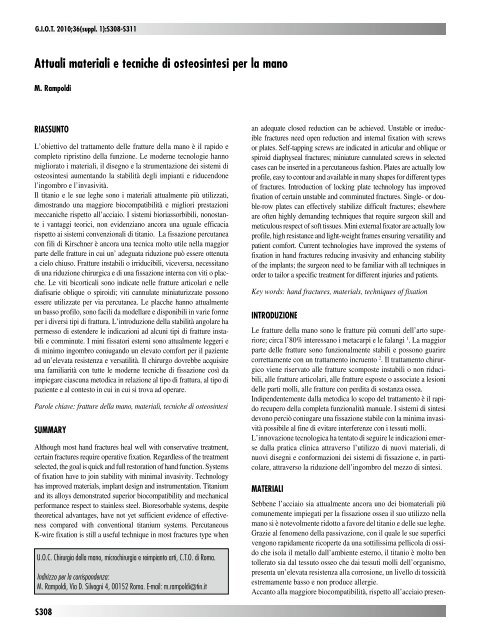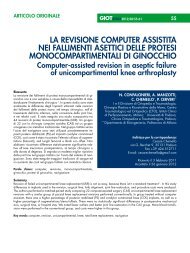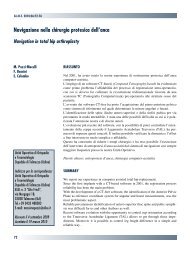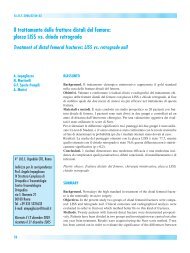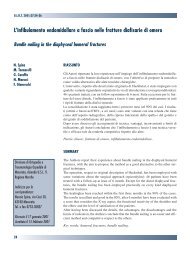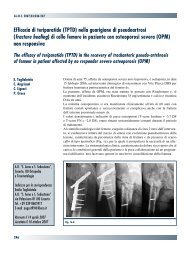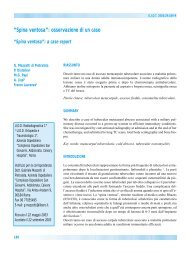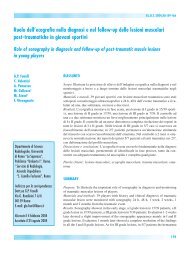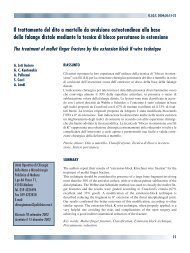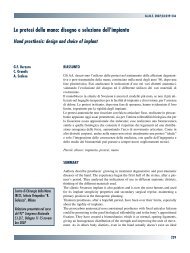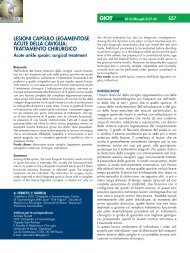30845 Suppl Giot.pdf - Giornale Italiano di Ortopedia e Traumatologia
30845 Suppl Giot.pdf - Giornale Italiano di Ortopedia e Traumatologia
30845 Suppl Giot.pdf - Giornale Italiano di Ortopedia e Traumatologia
Create successful ePaper yourself
Turn your PDF publications into a flip-book with our unique Google optimized e-Paper software.
G.I.O.T. 2010;36(suppl. 1):S308-S311<br />
attuali materiali e tecniche <strong>di</strong> osteosintesi per la mano<br />
M. rampol<strong>di</strong><br />
rIaSSuNTO<br />
L’obiettivo del trattamento delle fratture della mano è il rapido e<br />
completo ripristino della funzione. Le moderne tecnologie hanno<br />
migliorato i materiali, il <strong>di</strong>segno e la strumentazione dei sistemi <strong>di</strong><br />
osteosintesi aumentando la stabilità degli impianti e riducendone<br />
l’ingombro e l’invasività.<br />
Il titanio e le sue leghe sono i materiali attualmente più utilizzati,<br />
<strong>di</strong>mostrando una maggiore biocompatibilità e migliori prestazioni<br />
meccaniche rispetto all’acciaio. I sistemi bioriassorbibili, nonostante<br />
i vantaggi teorici, non evidenziano ancora una uguale efficacia<br />
rispetto ai sistemi convenzionali <strong>di</strong> titanio. La fissazione percutanea<br />
con fili <strong>di</strong> Kirschner è ancora una tecnica molto utile nella maggior<br />
parte delle fratture in cui un’ adeguata riduzione può essere ottenuta<br />
a cielo chiuso. Fratture instabili o irriducibili, viceversa, necessitano<br />
<strong>di</strong> una riduzione chirurgica e <strong>di</strong> una fissazione interna con viti o placche.<br />
Le viti bicorticali sono in<strong>di</strong>cate nelle fratture articolari e nelle<br />
<strong>di</strong>afisarie oblique o spiroi<strong>di</strong>; viti cannulate miniaturizzate possono<br />
essere utilizzate per via percutanea. Le placche hanno attualmente<br />
un basso profilo, sono facili da modellare e <strong>di</strong>sponibili in varie forme<br />
per i <strong>di</strong>versi tipi <strong>di</strong> frattura. L’introduzione della stabilità angolare ha<br />
permesso <strong>di</strong> estendere le in<strong>di</strong>cazioni ad alcuni tipi <strong>di</strong> fratture instabili<br />
e comminute. I mini fissatori esterni sono attualmente leggeri e<br />
<strong>di</strong> minimo ingombro coniugando un elevato comfort per il paziente<br />
ad un’elevata resistenza e versatilità. Il chirurgo dovrebbe acquisire<br />
una familiarità con tutte le moderne tecniche <strong>di</strong> fissazione così da<br />
impiegare ciascuna meto<strong>di</strong>ca in relazione al tipo <strong>di</strong> frattura, al tipo <strong>di</strong><br />
paziente e al contesto in cui in cui si trova ad operare.<br />
Parole chiave: fratture della mano, materiali, tecniche <strong>di</strong> osteosintesi<br />
SuMMary<br />
Although most hand fractures heal well with conservative treatment,<br />
certain fractures require operative fixation. Regardless of the treatment<br />
selected, the goal is quick and full restoration of hand function. Systems<br />
of fixation have to join stability with minimal invasivity. Technology<br />
has improved materials, implant design and instrumentation. Titanium<br />
and its alloys demonstrated superior biocompatibility and mechanical<br />
performance respect to stainless steel. Bioresorbable systems, despite<br />
theoretical advantages, have not yet sufficient evidence of effectiveness<br />
compared with conventional titanium systems. Percutaneous<br />
K-wire fixation is still a useful technique in most fractures type when<br />
U.O.C. Chirurgia della mano, microchirurgia e reimpianto arti, C.T.O. <strong>di</strong> Roma.<br />
In<strong>di</strong>rizzo per la corrispondenza:<br />
M. Rampol<strong>di</strong>, Via D. Silvagni 4, 00152 Roma. E-mail: m.rampol<strong>di</strong>@tin.it<br />
S308<br />
an adequate closed reduction can be achieved. Unstable or irreducible<br />
fractures need open reduction and internal fixation with screws<br />
or plates. Self-tapping screws are in<strong>di</strong>cated in articular and oblique or<br />
spiroid <strong>di</strong>aphyseal fractures; miniature cannulated screws in selected<br />
cases can be inserted in a percutaneous fashion. Plates are actually low<br />
profile, easy to contour and available in many shapes for <strong>di</strong>fferent types<br />
of fractures. Introduction of locking plate technology has improved<br />
fixation of certain unstable and comminuted fractures. Single- or double-row<br />
plates can effectively stabilize <strong>di</strong>fficult fractures; elsewhere<br />
are often highly deman<strong>di</strong>ng techniques that require surgeon skill and<br />
meticulous respect of soft tissues. Mini external fixator are actually low<br />
profile, high resistance and light-weight frames ensuring versatility and<br />
patient comfort. Current technologies have improved the systems of<br />
fixation in hand fractures reducing invasivity and enhancing stability<br />
of the implants; the surgeon need to be familiar with all techniques in<br />
order to tailor a specific treatment for <strong>di</strong>fferent injuries and patients.<br />
Key words: hand fractures, materials, techniques of fixation<br />
INTrODuzIONE<br />
Le fratture della mano sono le fratture più comuni dell’arto superiore;<br />
circa l’80% interessano i metacarpi e le falangi 1 . La maggior<br />
parte delle fratture sono funzionalmente stabili e possono guarire<br />
correttamente con un trattamento incruento 2 . Il trattamento chirurgico<br />
viene riservato alle fratture scomposte instabili o non riducibili,<br />
alle fratture articolari, alle fratture esposte o associate a lesioni<br />
delle parti molli, alle fratture con per<strong>di</strong>ta <strong>di</strong> sostanza ossea.<br />
In<strong>di</strong>pendentemente dalla meto<strong>di</strong>ca lo scopo del trattamento è il rapido<br />
recupero della completa funzionalità manuale. I sistemi <strong>di</strong> sintesi<br />
devono perciò coniugare una fissazione stabile con la minima invasività<br />
possibile al fine <strong>di</strong> evitare interferenze con i tessuti molli.<br />
L’innovazione tecnologica ha tentato <strong>di</strong> seguire le in<strong>di</strong>cazioni emerse<br />
dalla pratica clinica attraverso l’utilizzo <strong>di</strong> nuovi materiali, <strong>di</strong><br />
nuovi <strong>di</strong>segni e conformazioni dei sistemi <strong>di</strong> fissazione e, in particolare,<br />
attraverso la riduzione dell’ingombro del mezzo <strong>di</strong> sintesi.<br />
MaTErIaLI<br />
Sebbene l’acciaio sia attualmente ancora uno dei biomateriali più<br />
comunemente impiegati per la fissazione ossea il suo utilizzo nella<br />
mano si è notevolmente ridotto a favore del titanio e delle sue leghe.<br />
Grazie al fenomeno della passivazione, con il quale le sue superfici<br />
vengono rapidamente ricoperte da una sottilissima pellicola <strong>di</strong> ossido<br />
che isola il metallo dall’ambiente esterno, il titanio è molto ben<br />
tollerato sia dal tessuto osseo che dai tessuti molli dell’organismo,<br />
presenta un’elevata resistenza alla corrosione, un livello <strong>di</strong> tossicità<br />
estremamente basso e non produce allergie.<br />
Accanto alla maggiore biocompatibilità, rispetto all’acciaio presen


